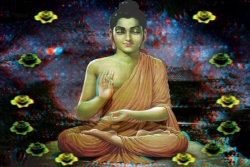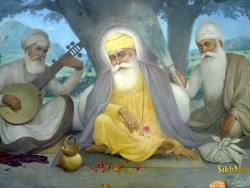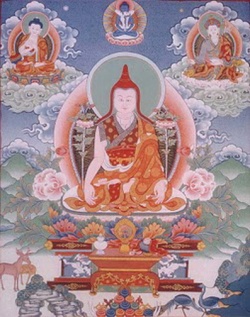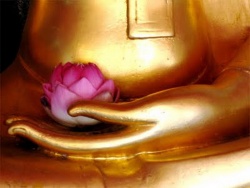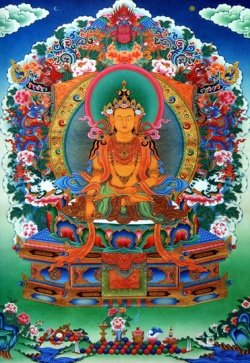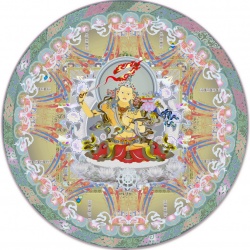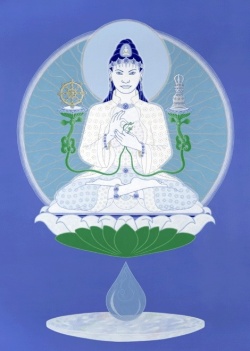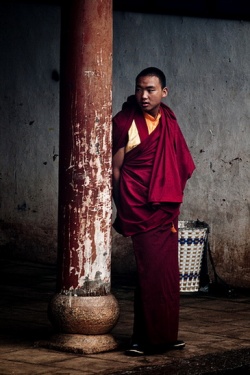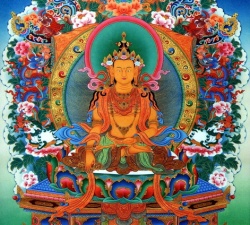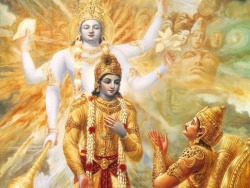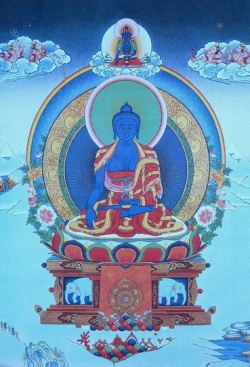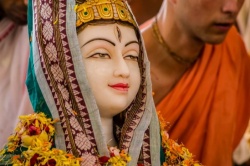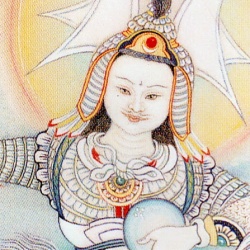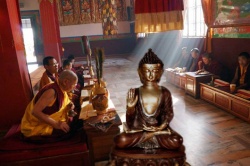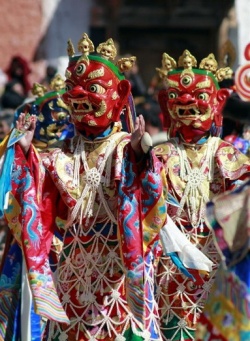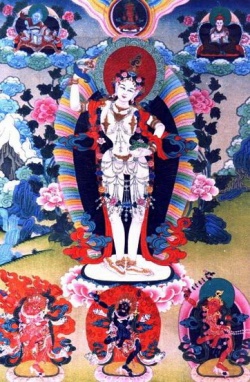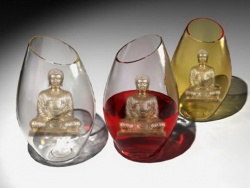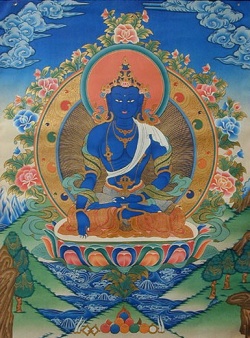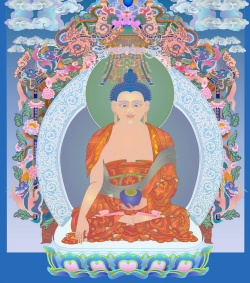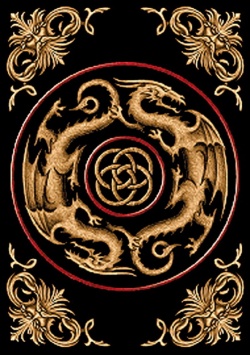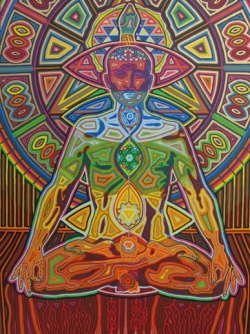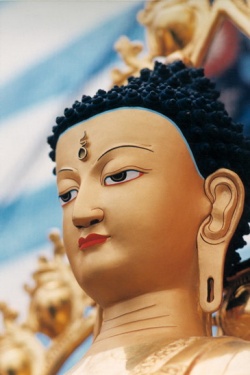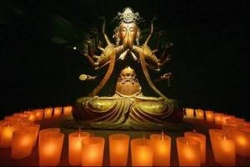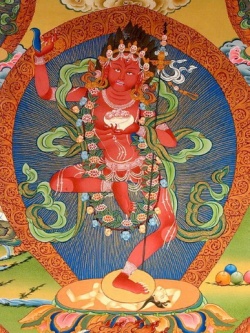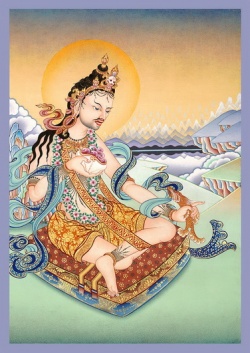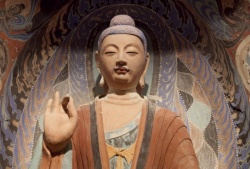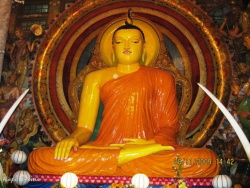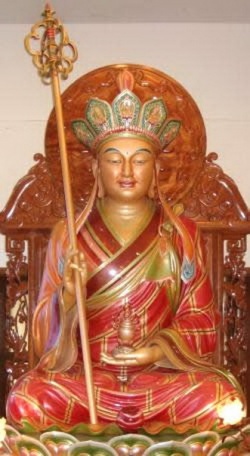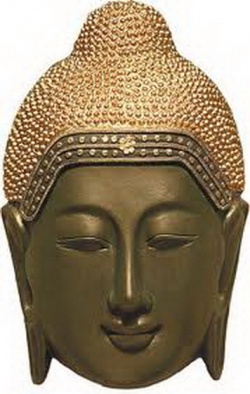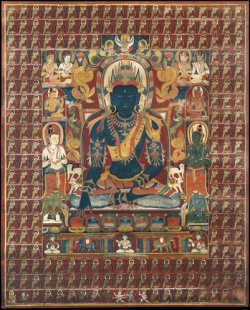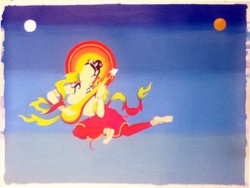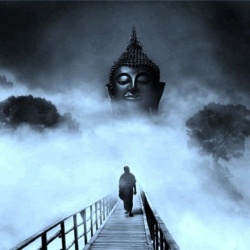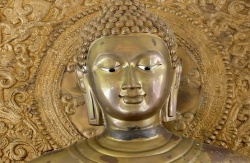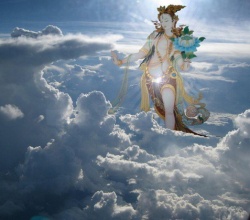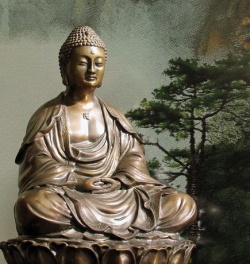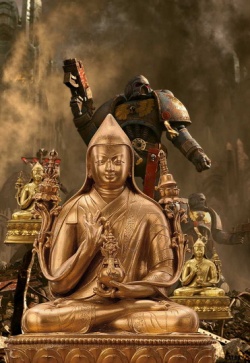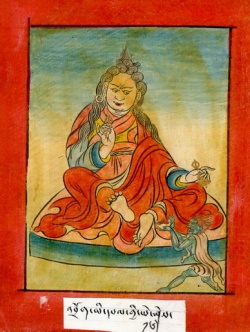The Buddha Speaks of Amitabha Buddha Sutra Part 4
Dependent adornments to bring forth faith and joyfaith and joy faith and joy faith and joy faith and joy Sutra Text: At that time, the Buddha told the Elder Shariputra: From here, passing through hundreds of thousands of millions of Buddhalands to the west there is a world called Utmost Bliss. In this land a Buddha called Amitabha right now teaches the Dharma. Sutra Commentary: At that time, the Buddha told the Elder Shariputra: This inconceivable Dharma Door will inevitably cause skepticism because of its depth. Breadthwise, it can universally gather in the three roots: 1. Greed, anger and stupidity. 2. Superior, medium and inferior
3. The Confused, those of Two Vehicles and the Bodhisattvas.
In addition, the Pure Land Dharma Door can perfectly en-compass and surpass all the other Dharma Doors. It is most profound and difficult to believe. That is why the Buddha chose to explain it to Ven. Shariputra, who is foremost in wisdom among his Arhat disciples. Without wisdom and sufficient blessings, one cannot help but be skeptical. Even those who have opened their Heavenly Eye cannot see this. Shakyamuni spoke without being asked, wishing the Sound Hearers to open their Dharma Eye, see the Pure Lands, serve the Buddhas of the ten directions and extensively study the Bodhisattva path.
Question: Why address Shariputra and not a Bodhisattva Answer: Bodhisattvas have eliminated defilement seeds and can reside in the Pure Lands. Sound Hearers still discriminate and the impure lands differ widely. To inform the Sound Hearers’ leader can cause them joy and make them admire this superior Dharma. Question: Why only Shariputra and not the other Sound Hearers Answer: The Buddha decided to start with teaching the teachers. From here, passing through hundreds of thousands of millions of Buddhalands to the west there is a world called Utmost Bliss. “Passing through ten billion worlds” symbolizes subduing the ten servants/afflictions. The number ten symbolizes the many: multiply by ten to reach increasingly large numbers.
This symbolizes the manner in which the mind becomes pure by surpassing the limitless afflictions, thus purifying the land. This is what Amitabha did while he was Dharma Treasury Bhikshu: he made 48 great vows to purify his afflictions in order to save living beings. There are twenty layers of world seeds. The Saha world and Western Bliss Pure Land are both at layer thirteen. That is why we go horizontally from our world in the western direction to get to Amitabha’s. A Buddhaland is also called the Three Thousand Great Thou-sand Worlds. Each world system has at its center a Mount Sumeru (Sanskrit for “wonderfully high”) made of four jewels, a moon and a sun. Each of the four directions has a continent. Then the mountain and continents cluster is surrounded by a great ocean that is 84,000 yojanas wide. The eastern continent is called Purvavideha , meaning “superior body.”
This continent is named for the inhabit-ants’ superior bodies. They are eight elbows tall, and live to be 250 years old. The western continent is called Aparagodaniya , meaning “cattle goods.” There they use cattle as goods. This continent is named for its animals. In addition, the humans there are sixteen elbows tall and live to the age of 500 years. The southern continent is called Jambudvipa , meaning “superior gold”, and is named after a tree. The sap of this kind of tree flows into water and turns sand and stones into a special kind of gold that is even better than normal gold. Humans in this continent are 3.5 elbows tall and live to be less than 100 years old. The northern continent is called Uttarakuru , meaning “superior place” . This continent is superior to the other three. People there are 32 elbows tall and live to be 1,000 years old.
These four continents are surrounded by a steel mountain range that is outside of the great ocean that encircles the four continents. Everything is illuminated by a moon and sun, located half way up Mount Sumeru, which is 42,000 yojanas tall—at the same level as the Four Heavenly Kings heaven. All of the above makes up “a small world system ”, also called “one set of four continents under heaven .” Above are Six Desire Heavens and the First Dhyana Heaven. One thousand small world systems of the above are called a Small Thousand World System. One thousand Small Thousand World Systems is called Mid-dle Thousand World System (at the very top of which is the Third Dhyana Heaven). One thousand Middle Thousand World Systems is called a Great Thousand World System (at the very top is the Fourth Dhyana Heaven). And Three Thousand Great Thousand World Systems form a Buddhaland.
Question:
Why to the west Answer: This is not a good question! You might have asked why it is to the east if that’s what the Sutra said! The Western Bliss Pure Land’s original Sanskrit word is Su-khavati , which means “Utmost Bliss” as well as “Peaceful Growth ”, “Peaceful and Blissful ” or “Pure and Peaceful .” The names differ slightly but the principles are the same. In the Pure Land, there is no birth and death, no afflictions, no pain and suffering and no danger. There is only sheer happiness and bliss. One eternally leaves the multitudes of suffering and secures the most peaceful and stable livelihood. In this land, there is a teaching host: a Buddha called Amitabha who right now teaches the Dharma. Amitabha means “limitless light.” He is also called Amitayus, Sanskrit for “limitless life.” This Buddha is still teaching the Dharma (in the present). This is unlike our world where Shakyamuni Buddha already taught the Dharma and Maitreya will teach the Dharma in the future.
Bodhisattvas see purity while living beings see defilements.
Therefore, unlike living beings’ worlds, the Bodhisattvas and Buddhas’ Pure Lands are not destroyed by the calamities. Pure Lands such as the Western Bliss Pure Land serve to gather in living beings. Impure Lands such the Saha world are for subduing living beings. We should further discuss the purity and defilements of the four types of Pure Land that are present in the Western Bliss Pure Land:
1. Ordinary Beings and Sages Cohabiting Pure Land . Let’s discern the marks of purity and defilements of this kind of land. The Shurangama Sutra describes turbidity as throwing mud into clear and set-tled water. The Saha world has the five turbidities and thus is defiled. The Western Bliss Pure land in contrast is like muddy water that has settled and is therefore pure.
2. The Pure Land of Expedients with Residues , also called Transformation City. This is at-tained by cultivators of the Two Vehicles. It is also inhabited by those who have not broken through to ig-norance. They have already emptied their self and thus are pure. This part of the Western Bliss Pure Land is therefore considered pure.
3. Actual Reward without Obstructions Pure Land . This Pure Land is very adorned. Even Bodhisattvas of Equal Enlightenment stay here. It is also pure.
4. Permanently Still and Bright Pure Land : This is the Pure Land of the Buddhas. The Western Bliss Pure Land’s first kind of Pure Land is pure and thus is unique in all Buddhalands. For example, in our Saha world, we also have ordinary people and sages cohabititing, but it is not considered to be a Pure Land because ordinary people lean toward creating offenses. They do not like to cultivate and often draw disasters and difficulties upon themselves. Our bodies are from the uniting of various karmic obstructions. The Buddhas are different: 1. The Buddhas’ Dharma Body is from the uniting of the principles .
The principles are equal with-out distinction and are present everywhere. That is why the Dharma body is everywhere present. 2. The Buddhas’ Reward Body is from the purification of all doubts and the perfection of wisdom , taking wisdom as its body. In fact, it manifests from the later acquired wisdom , refer-ring to the Bodhisattva’s developed wisdom after they acquired Prajna wisdom. Those of Two Vehicles can-not see the Reward Body with their eyes. 3. The Buddha’s Response Body, or Transformation Body, is from the union of all living beings’ conditions
. Thus when living beings’ conditions or roots ripen , the Buddhas appear in response and take on the form of living beings in the various nine realms, adorned with the 32 hallmarks and 80 subtle characteristics. Although there are three bodies, they are actually just one: from the same substance that manifests differently according to conditions. Amitabha Buddha is therefore a transformation body in the Ordinary and Sages Cohabiting Pure Land. Those wishing to be reborn to the Western Bliss Pure Land should cultivate three types of blessings:
1. To be filial to their parents, to serve teachers and elders, practice kindness, not to kill and to practice the ten good deeds.
2. To take refuge with the Triple Jewel, to observe the precepts and not to violate the comportments.
3. To bring forth the Bodhi mind, to deeply believe in cause and effect, to read and recite Mahayana sutras, and to encourage others to draw near and practice the Dharma. These are the three proper causes and conditions for rebirth to all the Pure Lands.
There is has four meanings:
1. It’s for real: This is to cause living beings to admire and seek rebirth to that Pure Land.
2. These are true words: They can make the listeners be-come single-minded.
3. What is described is not the Illusory City. It is not an illusion. It is not a provisional manifestation or a conditioned appearance or false reflection. It is free from attachments to the two extremes. It can destroy the demons, and the Provisional or Small Vehicle attachments.
4. It is a perfect manifestation of the true nature that one can certify to. Right now teaches the Dharma:
This refers to the proper and dependent retributions, not the past, not the future. This Buddha is constantly teaching the Dharma, unlike in our Saha world where Shakyamuni has already finished speaking Dharma. We must wait for quite a while until Maitreya appears in the world to speak Dharma. Therefore, quickly go to the west, draw near Amitabha Buddha, horizontally escape the Triple Realm and learn the Great Vehicle Dharma from the Buddha and Bodhisattvas. Again: 1. “There is”: Indicating now, reaffirming faith. 2. “Western Bliss Pure Land”: It does exist; therefore make the vow to be reborn there.
3. “Amitabha”: He is the current teaching host. There-fore, vigorously practice, recite his name and seek his help in being reborn to his Pure Land. Question: The bliss in all the Pure Lands of the ten directions is the same. Why do you recommend rebirth to the Western Pure Land and not the other Pure Lands
Answer: Ordinary people have heavy karma. They are greedy for everything. If we don’t give them a target, they cannot focus. That’s why the Lotus Sutra says, “Living beings grasp everywhere. They should be led to liberation. Furthermore, the host of the Western Pure Land has superior vows that are particularly strong. We should take advantage and exhort living beings to ride on his vow power to obtain rebirth.” Sutra Text: Shariputra, why is this land called Utmost Bliss All liv-ing beings of this country never suffer, but enjoy every bliss. Therefore it is called Utmost Bliss. Sutra Commentary: Shariputra, why is this land called Utmost Bliss Now Shakyamuni Buddha expands on “Utmost Bliss” so as to enable the listener to bring forth the faith. The Buddha both asks the question and answers it because even though Shariputra is foremost in wisdom, he still has no clue and does not know what to ask. All living beings of this country never suffer, but enjoy every bliss.
Living Beings are made up of the five skandhas of form, feeling, thought, formation and consciousness. One could also say that they are born from the union of all the Dharma marks. The body itself arises from the false union of the four great elements and belongs to the Form skandha. The first five consciousnesses recognize the five dusts, and make up the feeling skandha. The sixth consciousness climbs on the six dusts’ conditions and creates differentiation, therefore manifesting as the thought skandha. The seventh consciousness, is constantly evaluating, as thoughts follow one another ceaselessly. That is the formation skandha. And finally, the eighth consciousness stores the body and dependent retribu-tion seeds. It is just the consciousness skandha. All living being have these elements, from the lowliest up to the Bodhisattvas of the Equal Enlightenment position.
All living beings of this Buddhaland know no suffering be-cause they are born by transformation and maintain purity in their lives. Here in the Saha world, on the other hand, we are born by emotions, and consequently experience both suffering and happiness; we are adept at bearing all the suffering. If we can obtain rebirth to the Western Bliss Pure Land, our lifespan will be limitless, we have all six spiritual penetrations and will be able roam throughout the Dharma Realm with ease. Our heavenly clothes and food will be abundant and arrive as we wish. We will have no suffering at all. Day and night, we can listen to the Dharma and experience only the Dharma bliss. In the Pure Land, their bliss is unsurpassed. They experience only bliss unlike in our Saha world where our suffering and bliss are all mixed together! How’s that for happiness Is it news to anyone that suffering is self-inflicted Speaking of suffering, it can be of three types:
1. Suffering within suffering: Our body is the suffering retribution. We then undergo suffering on top of it. 2. Suffering of decay: In the Saha land, the nature of our happiness is short-lived. In other words, in our world, happiness or bliss is a type of suffering of decay. It is sad to realize that, in our world, there is no real happi-ness or bliss! It is kind of hard to accept isn’t it 3. Suffering of the life process. This is neither of the above two.
We renounce the feeling skandha and feel neither suffering nor pleasure. And yet no one can avoid the formation skandha’s ever changing flow. “Formation” refers to changing without rest and ultimately ending up in extinction. There is a beautiful anecdote of the mark of this type of suffering. Confucius was by a stream. He sighed and said, “It flows like this, unceasingly day and night! .” Ultimately, when we speak of the bliss in the Western Pure Land, it is in reference to the suffering of our Saha world. In particular, it is for the sake of creating the yearning to avoid the Saha world’s suffering and wishing to be reborn in the Land of Utmost Bliss. We can talk of the ten pairs of suffering and bliss opposites:
1. In the Saha world, we have the constant difficulty of encountering the Buddha whereas in the Western Pure Land, living beings meet with Amitabha as soon as their lotus flower blooms. Thus living beings live in a state of bliss because they have the ability to often draw near the Buddha.
2. Here, we have the suffering of not hearing the Buddhadharma. There, living beings obtain the bliss of having the water, bird and trees all proclaiming the Dharma.
3. The Saha world has the suffering of evil companions leading us astray and/or drawing us to the dark side. There, all beings have the bliss of being in a gathering of only good and superior people.
4. Here, we have suffering arising from the multitude of demon hordes from the outside and afflictions from the inside. In the Western Bliss Pure Land, living beings experience the bliss from the Buddha’s mindful protection and are shielded from demonic manifestations.
5. Here we have the suffering of getting caught up in the unceasing wheel of reincarnation. There, they horizontally escape birth and death and escape reincarnation forever.
6. Here, we have the suffering of easily sinking into the three evil paths. There, living beings have the bliss of forever escaping the three evil paths. They don’t even hear of the names of those three paths!
7. This world has the suffering of obstructions to cultivation arising from the dust conditions . There, they have no such difficulties.
8. Here, we have the suffering of a short life cycle that is full of hardship.
There, living beings’ life span is just as long as the Buddha’s, which is limitless. 9. Here we have the suffering of regression and abandonment in cultivation. There, living beings all are re- plete with the proper samadhi. They also have the bliss of non-regression.
10. Here, we have the suffering of the extreme difficulty in attaining the Way. There, they accomplish Buddhahood in one lifetime, experiencing the bliss of be-ing able to accomplish what is to be done. In the Saha world, we have the death of share section . Share refers to the limitation of the lifespan ,. Section refers to the size, height or length of the body. In the Western Bliss Pure Land, they have no such suffering. They are transformationally born from the lotus flower and obtain their last body. They will accomplish Buddhahood in one lifespan and therefore have no more share section birth and death. Speaking of the eight kinds of sufferings, keep in mind that:
1. In the Western Bliss Pure Land, they do not have the suffering of birth, having to stay for nine months in the womb and being born in a painful manner. Instead, they experience the bliss of being born by transformation from a flower.
2. They have no aging suffering. They all have the bliss of owning perfect features and body.
3. They have no sickness suffering. In contrast, they obtain self-mastery and security.
4. They have no suffering from the breaking apart of the four great elements, that is death. Instead, they obtain the bliss of a limitless lifespan.
5. There, they have no suffering from being apart from their loved ones. In fact, they have the bliss of being part of the sea-vast assembly of sages and worthy ones. 6. There is no suffering of being with those that one de-tests. Instead, they can draw near those of superior roots. 7. They have no suffering of not getting what they want. Indeed, they all obtain the bliss of naturally accomplishing things as they wish. 8. They have no suffering of the raging five skandhas. Instead, they illuminate their skandhas and see that they are all empty and thus obtain bliss. Question: That land has no suffering, why is it called Utmost Bliss Answer: To contrast it with the impure lands like ours where we experience “utmost suffering.” That did seem to have inspired quite a few living beings to seek rebirth there.
Question: Ordinary people loathe defilements and admire purity and tend to abandon suffering in favor of bliss. Why then call this the perfect sudden Dharma Door Bodhisattvas themselves do not seek Nirvana’s bliss and will not abandon rescuing living beings from their suffering. In fact, as far as Bodhisattvas are concerned, they are attached to neither suffering nor bliss; attachments to both grasping and abandoning are severed—this is the spirit of Mahayana. Why then are those who recite the Buddha’s name seeking rebirth not of the same mindset Answer: To obtain the Patience of the Non-production of Dharmas is still not enough to rescue living beings.
It is like a broken vessel that is sinking: both oneself and others cannot escape danger. We recite the Buddha’s name to seek rebirth to his land, to see him and listen to him speak Dharma, and to obtain the Patience of Non-production of Dharmas. Once we have accomplished this, then we will be able to go to all the Buddhalands to rescue living beings in order to perfect benefiting self and others. According to this strategy, to abandon the suffering of the Saha world is none other than seeking to rescue living beings from suffering. Thus, seeking rebirth to the Western Pure Land is the Bodhisattva’s mindset. Furthermore, to seek bliss is to ultimately be able to give bliss to all living beings, so that too is the Bodhisattva’s great mind-set. In contrast, the Small Vehicle practitioners are primarily concerned with their own welfare. Can that be called perfect sudden Dharma Question: Does the Western Bliss Pure Land belong to the Triple Realm Answer:
No, because:
1. There is no desire there and hence no Desire Realm.
2. The residents of the Western Bliss Pure Land dwell on the ground and therefore there is no Form Realm. 3. Furthermore, the residents have form and therefore do not belong to the Formless Realm. 4. Finally, all residents there have already transcended the Triple Realm: inside they create no defiled seeds, outside they are not confused by the externals. They have escaped the reincarnation wheel and permanently transcended the Triple Realm.
In the Land of Utmost Bliss, living beings obtain food and clothing simply by thinking of them. There is no need to labor for them! Thus far we have examined the suffering and bliss of the first kind of Pure Land: where commoners and sagely ones cohab-it. Let us now look into the second kind of Pure Land: those which have expedients with residues. In our world, advanced cultivators may experience the suffering of one-sided emptiness and stillness extinction . In contrast, in the Western Bliss Pure Land, the residents are not stuck in one-sided emptiness and stillness. They have the bliss of roaming spiritual powers to purify the Pure Lands and aid liv-ing beings.
As for the Pure Land of Actual Reward Adornments, Bodhisattvas there all entered through one mind and the three contemplations. Although the Dharma Realm has no distinction, the ignorance habit energies are lighter there and their contemplative wisdom is strong and sharp, unlike here in the Saha world where, though the three contemplative wisdoms are complete, the habit energies are still heavy and wisdom has slight imperfections. That is why it’s called an impure land. Thus, in the Pure Land of Actual Reward Adornments, Bodhisattvas receive inconceivable and unobstructed bliss.
The Ultimate Still Bright Pure Land is the state of the Buddha’s bliss. In contrast, our Saha land only pertains to the separate teaching where, although the first twelve ignorances are eradicated, the bliss is still not ultimate. Counting from the First Ground Bodhisattva to Buddhahood, there are twelve grades of ignorance that must be eliminated. Sutra Text: Moreover, Shariputra, this land of Utmost Bliss is completely surrounded by seven tiers of railings, seven layers of netting, and seven rows of trees, all formed from the four treasures, and for this reason called Utmost Bliss.
Sutra Commentary: Moreover, Shariputra, this land of Utmost Bliss is com-pletely surrounded by seven tiers of railings, seven layers of netting, and seven rows of trees, all formed from the four treasures, and for this reason called Utmost Bliss. Next, the Buddha describes the dependent retribution of the Western Bliss Pure Land. Even Ven. Shariputra has never seen these types of adornments before. All the adornments that can be seen by the Saha inhabitants are created from causes and conditions. They are all conditioned and are with-outflow dharmas. In contrast, all the adornments that can be seen by residents of the Western Bliss Pure Land are created from Amitabha’s blessings and virtues. Hence they are all unconditioned and are without-outflow dharmas.
Railings is a translation of the Chinese lán , representing horizontal barriers, and shn , representing vertical barriers. These railings adorn the borders and boundaries, symbolizing precepts. Netting is a translation of the Chinese luó wng . In the Western Pure Land, netting adorns empty space, representing concentration. Trees is a translation of the Chinese háng shù . In the Pure Land, trees adorn the roads and grounds. Each tree has seven layers of netting, all made from the treasures. Between the netting there are five billion wonderful flowers and extremely adorned palaces. The trees represent wisdom. Each layer interlaces with the next. Seven: Stands for seven classes, the classification of the 37 wings of enlightenment into seven groups: 1. Four Applications of Mindfulness 2. Four Right Efforts 3. Four Bases for Spiritual Powers
4. Five Roots
5. Five Powers
6. Seven Limbs of Enlightenment
7. Eight-fold Path
Formed from the four treasures of gold, silver, lapis lazuli and crystal. These four represent the four virtues of Nirvana (permanence, bliss, true self and purity). Or one could say that these four treasures represent the four Dharmas of Attraction that Amitabha Buddha uses in order to gather in living beings. In fact, the jewels are not limited to seven or four. They are layers upon layers of innumerable jewels. For example, when the Sutra talks of golden trees, it means that everything is made of gold: the roots, tree trunk, branch-es, leaves, flowers and fruits. In addition, there are trees with golden roots and silver trunks, where the branches, leaves, flowers and fruits are made of the two gems of gold and silver. There can be various combinations of the seven kinds of jewels.
The Contemplation Sutra provides details on the seven rows of trees. Each tree is 8,000 yojanas tall. Each flower and leaf is made of different kinds of jewels and colors. Rays of gold-en light radiate from those of lapis lazuli, and red light emanates from those of crystal, etc… There are nets of precious pearls covering the trees. Each row of trees has seven kinds of nets. Between each net, there are five hundred million wonderful flowers and palaces.
And this sutra only gives a brief description! Speaking of adornments:
1. In the Commoners and Sages Cohabiting Pure Land, the adornments are a response from superior good karmas. They also arise from the five grades of contemplation. Their substance is the condition-produced superior and wonderful five dusts.
2. In the Expedients Pure Land, the adornments are a response from the Emptiness contemplation wisdom. They are also a response from the three similar contemplations . Their substance is the Wonderful Emptiness Truth five dusts.
3. In the True Actual Reward Pure Land, the adornments are a response from the Wonderful Mundane Contemplation Wisdom. They are also a response from the partial certification of the three contemplations . Their substance is the Wonderful Mundane Truth limitless five dusts.
4. In the Eternally Still Bright Brightness Pure Land, the adornments are a response from the Middle Contemplation.
They also arise from the Ultimate three con-templations . Their substance is the Wonderful Middle Truth named nature five dusts . All adornments in this Western Bliss Pure Land are discerned to make it easier for living beings to understand. In fact, of the adornments in the four Pure Lands, all are produced from cause and condition dharmas, all are from the Emptiness, Mundane, and Middle contemplations. That is why in the Western Bliss Pure Land cohabiting purity, Emptiness and the Mundane are perfectly fused without any limit.
Question: The Still Bright Pure Land is just the principle nature , how can it have adornments Answer: Each and every adornment substance is totally the principle nature , each and every principle nature is replete with all adornments , just like all the Buddhas’ ultimate dependent retribution . If the Still Bright Pure Land were not replete with the superior wonderful five dusts, it would not be different from the one-sided emptiness dharma nature. The inhabitants of the Western Pure Land are endowed with the eight great freedoms of the self:
1. One body can manifest limitless bodies.
2. One body the size of a dust mote can completely fill the great thousand world systems.
3. The great body can float or fly to distant places.
4. One can manifest limitless kinds of living beings.
5. All sense organs are used interchangeably.
6. One can obtain all dharmas without the thought of any dharma being obtained. This is described as “no wisdom, no attaining” in the Heart Sutra. 7. The meaning of one verse can be explained in limitless eons. 8. The body pervades all places like empty space. Question: The railings, nets and rows of trees are seven-layered. Why seven and not another number
Answer: This symbolizes that those who get reborn there all obtain the seven limbs of enlightenment. Their body, mouth and seven karmas have no flaws because they are endowed with the seven sagely treasures. Sutra Text:
Moreover, Shariputra, in the land of Utmost Bliss are pools of the seven jewels, filled with the waters of eight meritorious qualities; the bottom of each pool is pure, covered with golden sands. On the four sides are stairs of gold, silver, lapis lazuli and crystal. Above are raised pavilions adorned with gold, silver, lapis lazuli, crystal, mother-of pearl, red pearls and carnelian. In the pools bloom lotuses as large as carriage wheels with colors of green light, red light, yellow light, and white light, subtle, rare, fragrant, and pure. Shariputra, the Land of Utmost Bliss is adorned with splendor and virtues such as these. Sutra Commentary: We’ve just finished describing the land or place where living beings reside in the previous section. This section details the natural lotus pools where living beings are born. Moreover, Shariputra, in the land of Utmost Bliss are pools made of the seven jewels.
The seven jewels are:
1. Gold, which comes in up to five colors, with yellow/gold being the best quality. Gold can be buried a
long time without any damage. It can be worked with-out losing its properties. Also, it is produced between dirt; that is why the Chinese character for gold has the dust character at its center .
2. Silver.
3. Lapis Lazuli , which also has five colors.
4. Crystal . The Wisdom shastra says that crystals are stones that came from grottos in the mountains. They were frozen for one thousand years before becoming crystal. However, in the Pure Land, there is no cold or heat, and the earth never freezes up. How can crystals be formed Even though crystal is a type of stone, it is not real stone.
5. Mother of pearl .
6. Red pearl .
7. Carnelian .
Our Saha world has stones and gravel that comes about from our with-outflow deluded karmas. In the Western Bliss Pure Land, the jewels are from the non-outflow pure karmas. The Large Amitabha Sutra gives us more details: it states that in-side, outside, left and right all have pools of lotuses as large as ten yojanas up to twenty or thirty yojanas. Some pools are even as large as ten thousand yojanas. Some are as large as the ocean. Each pool is made of one, two or up to seven jewels. Filled with the waters of eight meritorious qualities The water of the pools has eight meritorious virtues:
1. Tepid : It is warm or cool to each individual’s liking. In contrast, in our Saha world, water can be quite cold or hot.
2. Clear : It does not ever get dirty, unlike our Saha world, where water can be dirty and turbid.
3. Pure : It tastes sweet and delicious. Here, our water can be salty, bland or inferior tasting.
4. Soft : It feels light and soft, as compared to our water which can be hard and heavy.
5. Moistening : It washes dirt right off. In contrast to our water which can be foul smelling, its taste can change over time, its color can change over time, and its stagnancy can allow germs to proliferate.
6. Harmonizing : This water makes your heart and mind be at peace as opposed to our rushing and sometimes violent waters.
7. Banishing hunger and thirst .
8. Nourishing all roots , as opposed to our waters which can harm all roots, drown people and allow illnesses to multiply.
The water there is not just endowed with eight virtues; it actually has numberless virtues. The Contemplation Sutra states that each pool is made of the seven jewels. Each jewel is very soft, born from the as-you-wish pearl king.
The pools branch out into fourteen streams. Each branch has the seven jewel colors, its many colored water flows between the flowers and speaks the Dharma of suffering, impermanence, no-self and emptiness. The Limitless Life Sutra says that when those good and superior rooted living beings enter those pools, the water’s temperature changes to cool or warm, according with their individual wishes. Furthermore, the water can make them become open-minded and at ease in their bodies. It can help them get rid of the impurities of their minds while cleansing their physical bodies. This kind of water has no mark because it can accord with living beings’ wishes. Its virtues are truly inconceivable. Unlike the water of our world which can either dry up or cause flooding, this water is just right. It is of the appropriate depth for each individual. For example, if one wishes to wash the upper torso, the water level naturally rises. When done, it automatically lowers to the knee level to allow for washing the lower legs.
The water is exactly as one wishes. The water in the pools flows gently, neither fast nor slow. Its surface is riddled with countless tiny waves. There are natural sounds of reciting the Buddha’s name, literary wisdom Dharma sounds , literary wisdom sanghan sounds , still and quiet sounds, emptiness and no-self sounds, great kindness and compassion sounds, Paramita sounds, as well as multitudes of other wonderful Dharma sounds. Whatever Dharma one wishes to hear can be heard. Hearing the sounds will give rise to a mind of purity, bring one’s roots to maturity and obtain non-regression from unsurpassed Bodhi. Although the water is intrinsically insentient, it can nonetheless speak such incon-ceivable Dharmas and speak of the Paramitas.
After bathing in the water, some might sit on the lotus dais or some might sit on the ground to speak sutras, read sutras, learn sutras, receive sutras, listen to sutras, recite sutras, con-template the Way, sit in meditation or practice walking medi-tation. Some could be doing such activities in space as their abilities allow them to do so. Those who have not yet ob-tained the fourth fruition of Arhatship can obtain it, thanks to those practice causes. Those who have not reached non-regression Bodhisattva grounds can thereby reach them. The water is just a touch dharma, and yet it can have such inconceivable qualities! The bottom of each pool is pure, covered with golden sands.
There is only a brief description of the bottom of the pool. The Contemplation Sutra gives more details: the golden sands really have many-colored Vajra gems. The Large Amitabha Sutra (which will also be referred to as simply The Large Sutra) says that the bottom of each pool actually has all sorts of jewel sands. Each pool is as large a hundred great seas. The carriage wheels on the chariots of the Wheel Turning Sage King are one yojana in diameter. A small yojana is forty miles, a middle yojana is sixty and a large yojana is eighty miles. Each lotus is eighty miles in diameter. The pools may look like water but feels as if there is nothing at the touch. The water is sublimely fragrant.
On the four sides are stairs of gold, silver, lapis lazuli and crystal. The pools are surrounded by pathways which are made from the four gems. Above are raised pavilions adorned with gold, silver, lapis lazuli, crystal, mother-of pearl, red pearls and carnelian. Many tall palaces have multiple stories and are situated be-tween the pools and above the flowers. There are countless numbers of these palaces. Stairs allow for ascension to pavilions where the sangha lives and where the Dharma is spoken. The Limitless Life Sutra states that Amitabha Buddha’s Dharma hall is adorned with the seven jewels. For example, the palaces of the sixth desire heaven are adorned with the seven jewels, and are a hundred thousand ten thousand times more adorned than in the human realm. Moreover, the Bodhisattvas’ palaces are also a hundred thousand ten thousand times more adorned than the heavenly palaces. Here the same multiplier applies. Gold is listed first because of its four virtues: 1. Its body is durable. 2. Its nature is soft and malleable.
3. Its color is bright.
4. It is expensive and prized.
In the pools bloom lotuses as large as carriage wheels with colors of green light, red light, yellow light, and white light, subtle, rare, fragrant, and pure. The four color lo-tuses emit light representing the Four Applications of Mind- fulness, the Four Right Efforts and Four Bases for Spiritual Powers.
The four colors that are emitted are:
1. Blue, for the Utpala , a Sanskrit term for blue lotuses symbolizing the Ten Dwellings.
2. Yellow, for the Kumuda , symbolizing the Ten Practices.
3. Red, for the Padma , symbolizing the Ten Transferences.
4. White, for the Pundarika , symbolizing the Ten Grounds.
The four colors therefore represent the forty positions and causal virtues . They thus come about from the fruition. The four colored lotuses are thus the fruition re-sponses . The Contemplation Sutra says that there are limitless jewels that adorn those carriage wheel lotuses in the Western Bliss Pure Land. Each lotus pool has sixty hundred million lotuses of the seven jewels. The Large Sutra says that each lotus ranges from one yojana to one thousand yojanas. Each lotus is of a different size depending on the gongfu of each reciter. The more one recites, the bigger it becomes, proportional to one’s recitation ability. On the other hand, if one stops reciting, it shrivels and dies. At the time of death, one is reborn onto this lotus. This is why it is said that we are reborn to the Pure Land with lotus flowers as parents.
It is a pure form of birth. When the lotus flower opens, we immediately get to see Amitabha Buddha. The carriage wheel here has the meaning that this Dharma can reach throughout the ten directions to ferry living beings back to the Western Bliss Pure Land for rebirth, relying on Amitabha Buddha’s great powers. Only four colors are men-tioned but in actuality, there are limitless colors. Question: Why only mention four colors Answer: These are four colors which are actual and not false. They symbolize the fact that the inhabitants of Western Bliss Pure Land do not flatter, or use tortuous words. They can accomplish the four kinds of Nirvana and obtain the four Wisdoms. Subtle , rare , fragrant , and pure : These qualities symbolize the four virtues of the lotuses:
“Subtle” reflects the quality and substance and not the shape. Each lotus manifests various forms depending on one’s strength of mindfulness.
“Rare” means unobstructed: Having self-mastery without obstructions is a reflection of living beings’ recitation gongfu.
“Fragrant”: It is more fragrant than our world’s fragrance. On the causal grounds, Amitabha was replete with the fragrances of the three non-outflow studies: precepts, samadhi and wisdom. Now at the fruition of his cultivation, the lotuses’ fragrance is inconceivable.
“Pure” denotes that it’s not defiled by dusts. It reflects our pure and wonderful Bodhi mind. The lotus concept is rather special. It denotes the following:
A place of residence, unbounded (unlike walled within palace grounds) and serving as a shelter for the wis-dom life.
The Western Bliss Pure Land is often called the Lotus Country.
The Pure Land Dharma Door is often called the Pure Land Sect.
The Recitation Assembly is often referred to as the Lotus Society.
The co-cultivators are often called lotus companions.
Shariputra, the Land of Utmost Bliss is adorned with splendor and virtues such as these: All the adornments are accomplished from Amitabha Buddha’s great vows and great practices. They arise from his merit and virtues! Adorned , refers to Amitabha Buddha’s ability to accomplish the afore-mentioned pools, pathways, palaces, pavilions, lotuses, etc . Such as these refers to the various states of use retribution such as the water qualities, pool sizes and shapes etc… Speaking of adornments, Amitabha’s 32nd vow says, “If I be-come a Buddha, from the ground to the sky, everything will be made of the limitless jewels, replete with the hundred thousand kinds of fragrance. All will be extremely adorned; exceeding those of the heaven and human realms. Their fra-grance will pervade the ten directions.
All the Sound Hearers and Bodhisattvas will practice the Buddha Way. If not so, I will not accomplish the Way.” Afterwards, he spent asam-khyeya kalpas practicing the Bodhisattva path (great practic-es). In fact, The Large Sutra says that in the causal ground, Amitabha Buddha selected 21 hundred million Buddhalands’ purification practices when he was in front of World Self-Mastery King Buddha. Amitabha Buddha made great vows and accomplished all his profound practices. Living beings can simply ride on them by reciting his name and thus also accomplish the same kinds of merit and virtues. At the noumenon level, all the adornments come from his mind which is not separate from all living beings. The Buddha starts out by immediately describing the land of Utmost Bliss (dependent retribution) in order to inspire faith in the listeners.
Question: Why do the Western Buddha and sages seem to be greedy for flowers and beauty Are they advocating beauty In our land, the sages and worthy ones stay in thatched huts. They avoid palaces, preferring small quarters. Some even live in alleys or slums. Here, we honor their virtues and do not value their adornments. Those who understand are not impressed with styles or appearances. Answer: The adornments are the fruition of Amitabha Bud-dha’s vows. They are also a response from the pure conduct of superior and good people. They do not require special ef-forts or labor.
Furthermore, the inconceivable adornments are the result of Amitabha Buddha’s use of expedients. He ac-cords with living beings’ natural abhorrence of defilements and admiration of purity. He therefore created the Western Bliss Pure Land so as to induce living beings of the ten direc-tions to desire the abandonment of suffering and seek bliss. They therefore bring forth the faith, make vows and recite his name to seek rebirth to his land and thus horizontally escape samsara.
This is such a beautiful expedient that typifies the edict: “First lure with desire and then later make them enter the Buddha’s wisdom .” This is what Great Master Hui Yuan refers to as: if one is in the midst of difficulties, hunger and cold and suddenly hears of a place where one can be safe, well-fed and have warm clothes, one cannot help but feel elated and jump up and down with joy, renounce the old and seek the new environment.
Because one who obtains rebirth will also ob-tain liberation, the Pure Land Dharma Door is an example of a greeting and guiding expedient . Virtues refer to non-outflow-nature virtues. The nature is fundamentally replete with all adornments. It cannot be real-ized without the Buddha’s power. Amitabha Buddha perfected his practices to adorn the Western Pure Land which can create conditions with living beings. Living beings use these conditions to adorn the Pure Land and give rise to abhorrance of the impure lands, wishing to leave them. They then engage in pure karmas and can be reborn from their own and other’s power. Outside of the nature, subject and object can-not be attained:
Subject: Amitabha can maintain. Object: the Western Bliss Pure Land can be maintained.
Subject: Amitabha’s virtues can adorn. Object: the Western Bliss Pure Land can be adorned.
Subject: Amitabha can adorn. Object: the Western Bliss Pure Land can be adorned.
There are three types of worlds:
1. Insentient : the Western Bliss Pure Land.
2. Sentient : Living beings.
3. Proper Enlightenment : The Buddha.
These three worlds can be united into one substance called Proper and Dependent (retributions) as One (True) Suchness . Self and other are not dual . All of the Buddhas are living beings . All others are the self . Sutra Text: Moreover, Shariputra, in this Buddhaland heavenly music always plays, and the ground is made of gold. In the six periods of the day and night a heavenly rain of mandara-va flowers falls, and throughout the clear morning, each living being of this land offers sacks filled with myriads of wonderful flowers to the hundreds of thousands of mil-lions of Buddhas of the other directions. At mealtime they return to their own countries and after eating they walk about. Shariputra, the Land of Utmost Bliss is adorned with splendor and virtues such as these. Sutra Commentary: Moreover, Shariputra, in this Buddhaland heavenly music always plays, and the ground is made of gold.
The Sutra then illustrates the superior state of the five dusts in the West-ern Bliss Pure Land: music (sound), ground (form), flower (form and smell), food (taste) and sacks of flowers/walking about (touch). The dusts of the Pure Land are subtle whereas those of our Saha world are coarse. This is because our minds are coarse therefore the dusts are coarse. When the mind is subtle, the dusts are correspondingly subtle. Unlike our world, in the Western Pure Land music always plays nonstop. Heavenly music fills empty space. Music re-fers to all the various musical instruments, suspended on trees or banner poles, all playing in a symphony that speaks Dhar-ma, causing the listeners to give rise to good thoughts. Music has two meanings: 1. Heavenly music offered up to the Buddha and assem-bly of sages. 2. Natural music which does not need human intervention and yet is naturally harmonized.
And the ground is made of gold on top, beneath which are the seven jewels. The inhabitants all emit light and therefore there is no need for light from the moon or sun. Unlike our Saha world, the Western Pure Land has no night since it is always bright. In the six periods of the day and night, three in each, a heavenly rain of mandarava flowers falls. In our Saha world, it rains in the south and snows in the north whereas in the Pure Land, it rains lotuses. As the flowers fall upon the ground, periodically the wind will automatically blow, clean-ing the ground of the flowers. Mandarava flowers translates into “as you wish ” or “white flower .”
They are usually rained down by heavenly beings, symbolizing making offerings. Mandarava flowers are heavenly flowers that are quite rare in other lands. ‘Flower’ represents all the other offerings, con-sistent with one of Universal Worthy Bodhisattva’s ten limit-less practices of widely practicing giving. As documented in the Dharma Flower Sutra, flowers have four virtues:
1. They adorn the Pure Land symbolizing that in that land, good dharmas are utilized to adorn the body.
2. The lotus flower blooms . This symboliz-es the Buddha wishing to reveal the One Vehicle Dharma, the true Dharma.
3. First flower, later fruit . The cause comes first and is then followed by its effect, symbolizing that rebirth to the Pure Land is the effect that followed from the previously planted causes of the past.
4. The fragrance is far reaching, making those who inhale it become delighted and blissful.
This represents the fact that the virtuous karmas and highly regarded repu-tation are far reaching throughout the ten directions. That is why it rains flowers. Question: What does the Pure Land’s white flower rain sym-bolize Answer: That only white karmas are practiced there. White is the basis for all colors, just like the One Vehicle is the source of all dharmas. And throughout the clear morning, each living being of this land offers sacks filled with myriads of wonderful flowers to the hundreds of thousands of millions of Bud-dhas of the other directions. Everyone is free to go as they please to make offerings to all the Buddhas of the ten direc-tions. They use sacks not only of white flowers but of all kinds.
There are also Maha Mandarava, great white flowers, and Mañjsaka and Maha Mañjsaka , great soft flowers. They go to other worlds to offer flowers and listen to the Buddhas in those worlds speak the Dharma. In our Saha world, we are just too busy earning a living, fighting for fame and profit. In contrast, the residents of the Western Pure Land are busy making offerings to the Buddhas, bowing to the Buddhas and practicing the paramitas. The four kinds of lotus flowers are used as offerings to the Buddhas of the other directions. This represents making sincere offerings to the Buddha fruition at all times, everywhere. The hundreds of thousands of millions: this is referring to the number of Buddhalands that had to be crossed to get to the Western Bliss Pure Land from the Saha world. Therefore, once in the Pure Land, we can always come back to make offerings to Shakyamuni and Maitreya Bodhisattva any time.
Actually, we can go anywhere to make offerings thanks to Amitabha’s spiritual powers; we can go anywhere in the ten directions as quickly as a finger snap. At mealtime they return to their own countries and after eating they walk about. This clearly demonstrates the fact that all the inhabitants of the Western Bliss Pure Land have incredible spiritual powers, in particular, they possess the spiritual foot . They can go to very faraway places to make offerings, yet still be able to make it back in time to eat. This is from Amitabha Buddha’s vow number 23, that all Bodhisattvas, relying on his spiritual powers, can in one in-stant go make offerings to the myriad Buddhas of the ten di-rections. This kind of spiritual penetration can be divided into three kinds:
1. One can get there : The body can fly or walk to faraway places. One can levitate effortlessly and go to distant places. 2. One can change into a small or big body, into one or many bodies. 3. A sagely as-you-wish state : One can transform and manifest as one wishes. One can make inconceivable transformations in order to respond and accord with living beings. Without leaving the West-ern Land, one can nonetheless be present in the lands of all directions.
To be able to go to distant Buddhalands (to make offerings) really means: 1. The Western Pure Land and the other Buddhalands are really not that far from each other. 2. One does not give rise to the total exhaustion samadhi and yet one can manifest all sorts of awesome deportments , just as the moon is instantaneously and simultaneously reflected on many water surfaces. They can rapidly return to the Western Country from the lands of the ten directions. This is kind of spiritual penetration is a response of their pure conduct. It is also sustained by Amitabha Buddha’s power. At a deeper level, this really means that each sound, each dust, and each ksana, including a snap of the fingers, is con-nected to the Triple Jewel of the ten directions without ob- structions. This is a manifestation of phenomenon not obstructing phenomenon .
The sub-stance of the Western Bliss Pure Land is the Dharma Realm and encompasses the Triple Jewel of the ten directions. Con-versely, the substance of the Triple Jewel of the ten directions is just the Dharma Realm and thus encompasses the proper and dependent retributions of the Western Utmost Bliss Pure Land. It is just like the pearl network of Shakra. Each pearl encompass many pearls. Many pearls also encompass each pearl. One and many mutually encompass each other without obstruction. In fact, in the Saha world, our turbidity is rather deep and heavy and our evil karmas create many obstructions. There-fore, although we are not separate we do feel separate; the Western Land seems so far away!
In contrast, in the land of Utmost Bliss, the merit and virtue are profound and therefore although it is separate, it does not feel separate. This is not different from the state of sages and mortals: separate and yet not separate ! At meal time, when they thinking of eating, food comes by itself, thus they can receive the natural bliss of eating. There is no need to prepare food or arrange the table. The food au-tomatically fills up the bowl with the right amount. There is no need to wash after eating. The Large Amitabha Sutra states, “At meal time, golden bowls, silver bowls, all sorts of precious bowls appear as one wishes, filled with the hundreds of flavors catering to each individual’s likings.” The food is as varied and delicious as you wish, yet it does not cause attachment as in our world.
How do they know when to eat A golden bell sounds by it-self when it’s time. Everyone hears the sound and gathers. Why do they still have to eat In the Actual Reward Pure Land, they use the Chan bliss as food. In the Transformation Pure Land, they rely on food to sustain the body. After eating, they walk about in:
1. The Buddha Hall
2. The beautiful forest
3. Or simply back and forth
Their feet walk while their mouths recite sutras.
After eating, they actually practice walking meditation and do not simply waste time walking! They contemplate the Bud-dha’s instructions enabling wisdom to manifest. Therefore, they equally practice blessings and wisdom. In fact, they never waste time, but are always applying themselves in cul-tivation. This kind of cultivation state is extremely blissful:
1. The Large Sutra says that the wind spontaneously blows from the four directions and produces the 500 types of sound, blowing through the flowers and trees. The flowers’ fragrance is therefore disseminated by the gentle wind in all directions. Even the nature of the metals is warm and soft.
2. The ground is flat. There are neither mountains nor seas. There are no pits, valleys or dark places.
3. When our roots are faced with the dusts, we still re-main in bliss.
4. That kind of bliss does not obstruct the Way but rather assists the Way.
Question: In the Western Pure Land, the environment is superior, people have put an end to ignorance, and the land has no day or night. How can one tell the time Answer: A golden bell resonates by itself or jade bells shake themselves, creating an impression of dawn. Some of the birds rest at night in the forests (i.e. they stop singing to indi-cate night time). The Bodhisattvas also create time and darkness manifestations which are far superior to indications of time in our world. Shariputra, the Land of Utmost Bliss is adorned with splendor and virtues such as these.
The Buddha reminds Ven. Shariputra that all of the adornments, splendor and vir-tues of the Western Land, such as heavenly music and flow-ers, spiritual traveling back and forth, food and walking medi-tation, etc., are adornments resulting from Amitabha Bud-dha’s vows, practices, merit and virtues. Sutra Text: Moreover, Shariputra, in this country there are always ra-re and unusual birds of many kinds and colors: white cranes, peacocks, parrots, egrets, kalavinkas and two-headed birds. In the six periods of the day and night the flocks of birds sing forth harmonious and elegant sounds.
Their clear and joyful calls proclaim the Five Roots, the Five Powers, the Seven Bodhi Shares, the Eightfold Path of Sages, and dharmas such as these. When living beings of this land hear their calls they are altogether mindful of the Buddha, mindful of the Dharma, and mindful of the Sangha. Sutra Commentary: Moreover, Shariputra, in this country there are always rare and unusual birds of many kinds and colors: white cranes, peacocks, parrots, egrets, kalavinkas and two-headed birds.
There are always (not sometimes!) all sorts of birds, though only six kinds are listed. Rare: Referring to their superior shapes. Unusual : They can speak Dharma. Many colored : They have colorful plumage.
White cranes are purely white, representing ortho-doxy. Some have red feathers on their heads while the rest of the body is as white as frost. They are very loud and dance very elegantly, unlike the other birds. Peacocks capture our attention with their elegant and frail beauty. These birds are innately spiritual and are quite different from ordinary animals. They wear a green crown and have very colorful bodies.
Parrots have beautiful and colorful bodies as well. Their feathers are emerald in color and their beaks are bright red. Their light feathers endow them with flight. Their tongue is thin and long, enabling them to speak. Egrets are pretty from a very young age. They can fly very far and soar high. Their sounds are very melodious. They are small and handsome but quite spiritual. These first four kinds of birds exist in the Saha world. Kalavinkas means “good sounding bird.” It sings more melodiously than any bird even before it has hatched (according to The Great Shastra). Its sound surpasses all those of the human and heavenly (kinnara) realms.
Only the Buddha’s voice sounds better. Their bodies are alluring. One cannot help but feel enthralled when hearing their sound. One cannot help but be captivated by their looks and one would never tire of looking at them. Two-headed birds have two heads on one body. They fly very fast and very lightly. They have a human face on a bird body. Husbands and wives who are heavily into sexual desire are reborn with two different consciousnesses in one body, although this retribution could not occur in the Pure Land, which has no animal realm. Rather and the birds there are transformations of Amitabha Buddha. However, these last two kinds of birds (kalavinkas and two-headed birds) exist in the Himalayas.
These birds continuously make sounds all the time. Those residents are born from transformation and do not need to sleep. Nor do the birds sleep, that is why they can also sing at night. Now, we explain the Dharma sounds. The sutra does not list them all. In the six periods of the day and night the flocks of birds sing forth harmonious and elegant sounds. Their clear and joyful calls proclaim the Five Roots, the Five Powers, the Seven Bodhi Shares, the Eightfold Path of Sages, and dharmas such as these. In that land, the birds sing non-stop, harmoniously as if in a symphony. The singing is done with fluidity and without obstruc-tions.
The 37 Wings of Enlightenment consist of seven groups: 1. Four Applications of Mindfulness.
2. Four Right Efforts.
3. Four Bases for Spiritual Powers.
4. Five Roots.
5. Five Powers.
6. Seven Limbs of Enlightenment.
7. Eight-fold Path.
The Great Wisdom Shastra says that within the 37 Wings of Enlightenment, no Dharma is excluded; there are measureless Dharmas within them.
The Nirvana Sutra says that if one can contemplate the Eight-fold Noble Path, one will see the Buddha nature and obtain awakening. The Four Contemplations (also known as the Four Applica-tions of Mindfulness) are different in the Pure Land because the inhabitants there do not have defiled bodies, or suffering:
1. Body Contemplation: In the Pure Land, the body is ul-timately pure unlike the defiled body that we have here in the Saha world.
2. Feeling Contemplation: The inhabitants all have in-conceivable bliss unlike here where we are constantly oppressed by multitudes of suffering.
3. Thought Contemplation: Their minds are true and ac-tual, apart from production, extinction and imperma-nence.
4. Dharma Contemplation: In the Pure Land, all five skandhas are really one’s self, unlike here where the dharmas have no self. These four have wisdom as their substance. Five Roots The word “root” has two meanings:
1. To be able to sustain , like the roots of trees which can sustain the branches and leaves, without which they would wither and die. 2. To be able to produce flowers and fruits, which symbolizes bringing to maturity. The Five Roots are:
1. Faith: In particular, faith in the Orthodox Dharma. This means believing in the Dharmas of the Proper Way (believing that all living beings are basically the Buddha, bringing forth the Bodhi mind and evolving toward Buddhahood) and Dharmas of Assisting the Way (aiding cultivation by practicing all good dharmas and planting the proper causes).
2. Vigor: To practice the Dharmas of the Proper Way and Aiding the Way without rest.
3. Mindfulness: To maintain constant awareness of the Dharmas of the Proper Way and Aiding the Way with-out any other thoughts.
4. Samadhi: To anchor the mind on the Dharmas of the Proper Way and Aiding the Way without any scatteredness.
5. Wisdom: With regard to Dharmas of the Proper Way and Aiding the Way, one’s wisdom clearly illuminates and discerns.
Great Master Man Yi said, “One should contemplate the Four Noble Truths and enable the wisdom light to manifest. Contemplate the Truth of Suffering and realize that its substance is the Dhar-ma Body. Contemplate the Truth of Accumulation and realize that its substance is just Prajna. Furthermore, the Truth of the Way is the cause for liberation and the Truth of Extinction is the liberation fruition. That is the wisdom root.” These five substances can be the basis for producing good-ness. The Five Roots mature into the Five Powers.
When the five roots mature, replete with all their powers and functionalities, they will not be subdued by other dharmas and can defeat and subdue such dharmas. The Five Powers are: 1. Faith Power: To deeply believe that mind is Buddha and that the mind acts as Buddha . It makes one capable of destroying living beings’ skepticism that they can also become the Buddha. Those who have this faith power cannot be moved by confusion. Deviant teachings cannot con-fuse and make them upside-down and they can sever afflictions and will not be invaded by them.
2. Vigor Power: To be able to overcome all kinds of bodily and mental laziness, to avoid harboring a view of a body, to valiantly labor and bear suffering, and not to become somnolent or sunk . This will en-able one to break through mental laziness and accom-plish the great transcendental work (of ending birth and death).
3. Mindfulness Power: To destroy all deviant thoughts, including those of one-sided emptiness or of existence, to harbor only proper thoughts, to accomplish the world transcending Middle Way Proper Mindfulness, and to be mindful of all merit and virtues.
4. Samadhi Power: To attain one mind unconfused, to overcome scatteredness and bring forth samadhi. Shallow gongfu will enable one to produce phenomenon samadhi, while deep gongfu will enable one to en-ter noumenon samadhi.
5. Wisdom Power: When the wisdom light penetrates through all confusion/ignorance, one will be able to produce non-outflow wisdom.
The substance of these Five Powers is the Five Roots. These powers are not easily subdued.
The Seven Bodhi Shares are also known as the Seven En-lightenment Shares. When the previous Five Wisdom Powers become solid, wisdom develops and one learns how to use it judiciously. Then one can awaken and understand. Those who certify to the proper positions will unfold actual wisdom and will use the following as limbs:
1. Selecting a Dharma : To be able to discern among the five Skandha dharmas, the false and proper dharmas, the proper ones being those which have no outflows. One will not select the false and erroneous dharmas. What are these wrong dharmas They are those which mistakenly take the five skandhas as the self. Fundamentally, the five skandhas are untrue dharmas but we incorrectly take them to be true. Marks of self and of dharmas are all false.
They are not in accord with non-outflow wisdom. In contrast, the true principle of the emptiness of self and dharmas is in accord with non-outflow wisdom. 2. Vigorously cultivate that Dharma; the Chinese tern is j ng j n . J ng means not mixed, or pure. n means not to regress, but rather to progress. One can be clear and aware while cultivating, not make the mistake of engaging in unbeneficial ascetic practices that will not transcend birth and death, and vigorously practice the True Dharma.
Pure Land prac-titioners can rely on the abhorrence and admiration Dharma Door to practice reciting the Buddha’s name, in order to renounce defilements and adopt purity, thus leaving suffering and attaining bliss. 3. Experience joy derived from practicing that Dhar-ma. After practicing the True Dharma long enough, one will obtain a response from the True Dharma and will be able to clearly understand that the bliss ob-tained is not from deviant dharmas such as attachment to nihilism, permanence, emptiness or existence. When Pure Land practitioners hear about reciting the Buddha’s name to obtain rebirth to the Pure Land, they become elated and they recite as instructed.
4. Casting out coarse delusions, which consist of view delusions and afflictions.
The view delusions are body , extreme , deviant , view , and precept delusions. These five are called quick servants be-cause they arrive very quickly. The afflictions are greed, hatred, stupidity, arrogance, and skepticism, which belong to thought delusions. These are known as the five dull servants because they are slower to ar-rive. These ten servants cause living beings to create karma and then undergo retribution, making them re-volve in the reincarnation wheel. However, if we can simply maintain the Buddha’s name, using that one thought to expel all other thoughts, we will gather in the six sense organs and cause pure thoughts to follow each other.
5. Renouncing subtle delusion: Once we have cast out the afore-mentioned view and affliction delusions, we become clearly aware that states are false, and are just like a dream. Then we will neither pursue nor value them any longer.
Pure Land practitioners can earnestly anchor the mind to a Buddha, abandon all kinds of conditions and produce the thought of abhorrence and wishing to leave this Saha world. 6. Samadhi : The externalists can attain the thought-less samadhi and can suspend the sixth consciousness. As a result, they can be reborn to the Heaven of No-thought, with a life span of 500 kalpas. During the first 499 kalpas they will not give rise to a single thought. However, during the second half of the last kalpa, they will lose their samadhi power and give rise to a thought again. Because they slander the Triple Jewel, they fall to the hells.
Some can reach the Neither Thought nor Non-thought Samadhi and enjoy heavenly bliss for 80,000 kalpas, but they too will eventually fall. Those who have not attained the Ex-tinction of Feeling and Thought Samadhi cannot end birth and death. Only the Proper Dharma can end love and view delusions. Pure Land practitioners aspire to always remain clear and aware that all samadhis are false. This way they will not become attached to the various samadhis. When our recitation of the Buddha’s name is deep and solid, our mind be-comes still and unencumbered. At this point, the mind will not move, be chaotic, or attach no anything what-soever.
7. Mindfulness : While cultivating the Proper Dharma, one must always maintain a balance between samadhi and wisdom (this is like the two legs in walking, or the birds’ two wings, or the cart’s two wheels).
When there is excessive samadhi power, the mind will sink . To counteract this, one must become aware and use the first three Bodhi shares: 1) selecting, 2) vigor and 3) joy. At other times, when there is ex-cessive wisdom power, the mind may become agitated . Then one should use the other three Bodhi shares to counteract the agitation, subduing and har-monizing the mind so that the balance between samad-hi power and wisdom power will be restored.
That’s mindfulness. The ancient sages say, “If there is a place where there is a Buddha, one should not linger there; if there is a place where there is no Buddha then hurry past it .” To attain the fruition requires passing through the two critical gates of existence and non-existence so that ultimately one recites and yet does not recite, one does not recite and yet recites. Eightfold Noble Path: These are also called the Eight Sagely Paths. Due to the first of the Seven Bodhi Shares, by select-ing the proper Dharma, one does not enter into the deviant paths. The Eightfold Noble Path, on the other hand, is proper and in this context “Path” indicates that it will lead to Nirvana. There are eight components:
1. Proper views of the principles: Not to indulge in views with outflows. One’s wisdom eye clearly illu- minates and one can see that the principle is proper and true .
2. Proper thoughts : Such thoughts are based on transcendental wisdom, rather than on the discriminating mind. Proper thoughts tally with the mind of non-outflows and their substance is wisdom.
They give rise to words and language that can connect with the thoughts of the Buddha’s. Proper thoughts can kick start awakening, understanding and assessment (of the Four Truths), enabling contemplative wisdom to in-crease. They therefore help sever delusion and certify to the truth, allowing entry to the Great Nirvana. 3. Proper speech : To refrain from committing the four evil mouth karmas and indulging in the four deviant mouth karmas, which are
1) direction mouth food : flattery and "kissing up” to the powers in the four directions;
2) intermediate (directions) mouth food : using mantras and divination skills;
3) upper mouth food : using knowledge of astrology; and
4) lower mouth food : farming or utilizing medicine. In maintaining proper speech, one does not use the aforementioned deviant mouth karmas to seek benefit and earn a living. One therefore does not commit the four evil mouth karmas of false speech, frivolous speech, coarse speech and double-tongue.
4. Proper action ( referring to body karma): To practice pure Brahman conduct, thus keeping the mind free from the three poisons. As the Shurangama Sutra puts it, “One does not kill, steal or engage in deviant sex.”
5. Proper livelihood : To have no evil mouth, body or mind karmas.
There are five kinds of deviant livelihoods for left-home people:
1) Falsely manifesting a strange style . This means intentionally behaving in a manner that is different from others, for instance by not eating the five grains, lying on nails, walking on fire, or doing “extraordinary” feats in order to inspire others to bring forth faith and admiration.
2) speaking of one’s own merit and virtues to entice or deceive others.
3) Fortune telling : one makes divinations, reads omens, makes predictions, or interprets auspiciousness or inauspiciousness.
4) Shouting and bragging in order to make others become respectful or fearful.
5) Speaking of one’s own offerings to impress others.
All these forms of livelihood are deviant means to obtain profit. One should be free from greed for fame or any wish for recognition. 6. Proper vigor : To cultivate Orthodox Dharma without laziness or boredom in a way that is in accord with non-outflow wisdom. 7. Proper concentration or samadhi : To always be in proper samadhi thereby not giving rise to deviant views. In this way, one distances oneself from scat-teredness, deviant samadhis, and from outflow samadhis, etc.
8. Proper mindfulness : To single-mindedly be mindful of True Suchness and the ten thousand aiding practices, using non-outflow wisdom to expel all false thinking. And dharmas such as these. As previously mentioned, there are many others such as The Four Dharmas of Attraction, The Four Fearlessnesses, The Six Paramitas, The Ten Powers, etc. Question: Why does the sutra not list thought contemplation , proper vigor , or spiritual foot Answer: In the Western Bliss Pure Land thought contempla-tion involves:
1) body contemplation (that the body is pure, being transformationally born from a lotus), and
2) feeling contemplation (that there is no suffering in the Western Bliss Pure Land).
Unlike our Saha world, in the Pure Land the body and feelings are not a cause of suffering. For this rea-son, thought contemplation is not listed in the sutra. Proper vigor is to contemplate that there is no evil, to refrain from letting any evil arise, and to cut off any evil which may have arisen. However, in the Land of Utmost Bliss everyone has superior roots and therefore no evil arises and there is no need to sever evil. Thus proper vigor is not mentioned in the sutra.
The power of spiritual foot arises from seeking external states , hoping to roam and valuing pleasure. However, everything is as one wishes in the West- ern Pure Land, so there is no need to seek. Hence the spiritu-al foot is also not listed in the sutra. The phrase “and other Dharmas such as these” refers to many additional teachings that are communicated by the birds and other manifestations in the Pure Land. Some of these other Dharmas are:
The Four Dharmas of Attraction:
1) Giving : We cannot help living beings with whom we have no affinities, which are also referred to as conditions. Therefore we must first start with giv-ing in order to create good affinities.
2) Kind words : Using soft spoken and endearing words that induce living beings to listen makes them more receptive to receiving help.
3) Beneficial practices : We roll up our sleeves and do whatever it takes to bring great benefits to all living beings.
4) Same work : Engaging in similar work in a common place together with those we wish to benefit, we thereby practice hidden virtue.
In order to succeed at this, we must know how to drift with the current and engage in “bonding” practices. The Six Paramitas: 1) Giving: To cure stinginess and greed.
2) Precepts: To cure all evils.
3) Patience: To cure anger and hatred.
4) Vigor: To cure laziness.
5) Samadhi: To cure scatteredness.
6) Wisdom: To cure stupidity.
These six are the Buddha’s Dharma medicine to heal living beings’ mind sicknesses.
Another set of Dharmas that are expounded in the Pure Land are The Ten Powers. All Buddhas have these powers:
1) Recognizing Right States and Wrong States Wisdom Power : They know all living be-ings’ causes, effects, and retributions. A right state, when cause and effect are in accord, occurs when one does good, thereby obtaining good retributions. On the other hand, a wrong state, when cause and effect seem to be not in accord, occurs when one creates bad karma yet expects a good retribution.
2) Karma Wisdom Power: The Buddhas know all liv-ing beings’ karmas of the three periods of time.
3) Samadhi Wisdom Power: They possess all the sa-madhis, worldly or transcendental (Hinayana and Ma-hayana).
4) Root Wisdom Power: They know all living beings’ roots, whether inferior or superior, enabling them to dispense appropriate teachings according to our capac-ities .
5) Desire Wisdom Power: The Buddhas know all liv-ing beings’ desires and attachments.
6) Realm Wisdom Power: They know the realm of all living beings.
7) Destination Wisdom Power: They know where each Dharma Door will lead to.
8) Past Lives Wisdom Power: They know every-thing that happened in the infinite number of past life-times of all living beings. 9) Heavenly Eyes Wisdom Power: The Buddhas know where living beings came from and where they are going. 10) Non-outflow Wisdom Power: Buddhas no long-er have to undergo further birth. In the Pure Land, one will also learn about The Four Fear-lessnesses:
1. All Wisdom Fearlessness : This en-tails knowing and seeing all Dharmas exhaustively . Exhaustively means completely. To know refers to the state of internal completeness in which nothing is not known. To see refers to external com-pleteness: nothing is not perceived. There is nothing that is not seen and there is nothing that is seen that is not understood. When both inside and outside are completely covered, how can there be any fear of fall-ing short in any way
2. Exhausted Outflow Fearlessness: When all out-flows are exhausted, the five dwellings are ultimate. The five dwellings will be elaborated lat-er. Also, the two deaths, share section and change deaths, permanently cease . Since there are no more outflows, how could there by any fear
3. Speaking of Obstructions to the Way Fearlessness (delusions, karmas and suffering can all create obstructions): Once we know of all of our obstructions and are not afraid to speak about them, we will have mastered this type of fearlessness. Typically, we either have no clue about our obstructions, or we wrongly believe that they are not obstructions. 4. Path to the End of Suffering Fearlessness : This fearlessness requires knowing, without any doubt, all the pathways (practice paths) that can lead to the end of suffering, and being able to explain them all without any fear. In addition, the Pure Land manifestations teach about The Five Dwellings, which are where afflictions reside. The Five Dwellings, which can also produce afflictions, are:
1. Views dwelling `: When one enters the Way, the various view delusions of the Tri-ple Realm are all severed at one place.
2. Desire and love dwelling : This includes all the afflictions of the Desire Realm, except for views and ignorance.
These afflictions arise from attaching to the five desires for externals. The externals are forms, sounds, fragrances, flavors and touches.
3. Form love dwelling : This dwelling includes all the afflic-tions of the Form Realm, except for views and igno-rance. At this level, one can detach from the five ex-ternal objects of desire but one nonetheless still attach-es to one’s own form body.
4. Existence love dwelling : This includes all the afflictions of the Formless Realm, except for those of views and igno-rance. At this level, one succeeds in separating from greed for the form body but one is still attached to the remaining bodily afflictions.
5. Ignorance dwelling : This final dwelling includes all the ignorance of the Triple Realm. Ignorance makes the mind become stupid and dark, and its substance is the absence of wisdom and brightness. Ignorance is the basis for all afflictions. The Consciousness Only School considers the delusions of the first four dwellings as the seeds for affliction obstructions, and the fifth dwelling as the seat for the obstructions of what is known.
The Tian Tai School considers the first dwelling as view de-lusions of the Triple Realm, the second through the fourth dwellings as thought delusions of the Triple Realm. The Two Vehicle practitioners sever these first four dwelling delusions and thereby transcend the Triple Realm. The fifth dwelling delusions belong to transcendental delusions —; if one can sever these, one can attain the Great Nirvana. Like the teachings mentioned above, the Four Proper Efforts are not directly mentioned in the sutra text. Also known as the Four Vigors, they are:
1) Putting an end to existing evil .
2) Preventing not yet arisen evil from arising .
3) Bringing not yet existent goodness into existence . In particular, it is important to accord with, guard and protect the non-outflow Proper Way so that there is no regression in cultivation and no disappear-ance of the Dharma, thereby preventing evil dharmas from arising.
4) Developing the goodness that already exists , causing it to grow and severing all evil. Vigor is also called proper severance . The final additional Dharmas which we will mention here are The Four Bases for Spiritual Powers , which can bring about spiritual powers and help one obtain what one de-sires.
They are:
1) Desire : For instance, we admire the Western Bliss Pure Land and subsequently can obtain rebirth there. 2) Vigor : The three kinds of non-regression can be obtained through vigor. 3) Mindfulness /: In thought after thought, staying mindful of the Bodhi vows and practices. 4) Thought /: Through thought, we can deeply enter the Buddha’s wisdom, and be at ease and in-creasingly bright . The Four Bases for Spiritual Powers take samadhi as their substance because they can be used to cultivate spiritual penetrations. The word ‘spiritual’ is used because one can make unimaginable transformations. Relying on samadhi power, one can use one’s mind in inconceivable ways. The word “Base ” indicates that that these powers can be relied upon. Relying on samadhi power one can obtain spiritual transformations. In general, living beings have limitless afflictions and illness-es. Therefore, the Buddha speaks of limitless Dharma Doors as medicine to counteract these afflictions. The teaching is thus dispensed according to living beings’ varying conditions and potentials. The 37 wings of enlightenment are different for each of the teaching periods (which are based on the writings of Great Master Zhi Zhe of the TianTai school):
1. The Store Teaching : This period refers to the three stores teaching of the Hinayana, while the re-maining three teachings belong to Mahayana. The store teaching is also called the half-word teaching . Hinayana teaches about the production and ex-tinction Four Noble Truths . Samadhi arises from these Four Truths. The Truth of Suffering indicates that the three marks of production, dwelling and extinction are constantly changing. The Truth of Accumulation teaches that greed, anger and stupidity, and the four minds all change and move. The four minds are: (1) the flesh mind ; 2) the conditioned and thinking mind , ; 3) the accruing and arising mind, which is the eighth consciousness that accumulates the seeds which in turn drive manifestations and behavior , ; and 4) the solid and true mind . The Truth of the Way can deal with and re-solve change and encroachment. The Truth of Extinc-tion indicates that both extinction and existence return to emptiness. .
2. The Connective Teaching : This teaching period is the entry Dharma Door to Mahayana, and is re-served for those with sharp roots. Sutras from this pe-riod teach about the non-production Four Noble Truths . The Truth of Suffering teaches that suf-fering is an illusion or a transformation without any mark of oppression. The Truth of Accumulation is al-so an illusion without any uniting marks. However, the Truth of the Way has the mark of non-duality and the Truth of Extinction has the no-production mark. .
3. The Separate Teaching : This set of teachings is only for Bodhisattvas and therefore is separate from the previous Connective Teaching and the subsequent Perfect Teaching. Sutras from this period teach the boundless Four Noble Truths . The Truth of Suffering has numberless marks because the retribu-tions in the ten realms are all different. The Truth of Accumulation also has numberless marks because the five dwelling afflictions are not the same in the various realms. The Truth of the Way has numberless marks because the Buddhas and Dharmas, both of which are as numerous as the Ganges’ sands, are all different. Finally, the Truth of Extinction states that the Par-amitas are all different.
4. The Perfect Teaching teaches the Non-action Four Truths (The Primary Meaning Truth ): Everything is the true mark of True Such-ness and requires no action. The Truth of Suffering states that the five skandhas are fundamentally the Treasury of the Thus Come One. Hence, there is no suffering that can be ended. The Truth of Accumula-tion states that affliction is just Bodhi, and thus there is no accumulation that can be severed. The Truth of the Way says that the extreme and the deviant are all the Middle Way, the Proper Way. Therefore there is no Way that can be cultivated. The Truth of Extinction says that birth and death are just Nirvana, and hence there is no extinction that can be certified to.
When living beings of this land hear their calls they are altogether mindful of the Buddha, mindful of the Dharma, and mindful of the Sangha. The Buddha has no fears and can explain all Dharmas. In the Western Bliss Pure Land, all the sounds speak Dharma. Living beings can obtain great benefits and naturally become mindful of the Triple Jewel by listening to them:
1. Amitabha Buddha is both kind (he wants to attract and gather in all living beings) and awe-inspiring (he is able to subdue beings with his awesome virtues ). Hence the residents are constantly aware of the Buddha’s presence and of his virtues: this is mindfulness of Buddha.
2. Mindfulness of the Dharma: Listening to the Dharma, naturally the mind becomes peaceful and blissful, making us remember what was heard and wanting to hear more.
3. Mindfulness of the Sangha: When we are able to draw near Good Knowing Advisers and receive instructions for cultivation, we can then certify according to the various milestones. We are naturally mindful of our teacher’s kindness, guidance and protection.
The Triple Jewel should be venerated because:
The Buddha Jewel is complete in wisdom and virtue.
The Dharma Jewel frees us from desire.
Sangha Jewel is the field of blessings.
Dwelling and maintaining the Triple Jewel :
The Buddha should be maintained by making images out of gold, silver, or wood; in addition, images could also be carved or molded.
The Dharma should be adorned in yellow, organized into rolls, and grouped into The Tripitaka.
The Sangha should be adorned, pure, and propagate the teachings.
The Triple Jewel is of one substance: it arises from the self-nature. The Buddha Jewel is the magical enlightenment sub-stance nature . It is perfect, bright, and exhaust-ively illuminating . The Dharma Jewel is the na-ture replete with limitless extolling-the-nature merit and vir-tue . The Sangha Jewel is the non-duality of the principles and wisdom , united and harmonious, devoid of contradiction (no fighting, and not violating the teachings). This one substance is the Triple Jewel of the self-nature. The mark of the nature is the One Suchness (both the nature and its marks are just one True Suchness), not separate, yet separate , free of discrimination and yet appearing to discriminate, dual yet not dual , seemingly relative but really not relative. Sangha is Sanskrit for united and harmonious assembly. Sanghans practice the six harmonies of:
1. Body: They dwell together .
2. Words: They do not fight .
3. Mind: They engage in the same work .
4. Precepts: They co-cultivate .
5. Views: They have the same understanding .
6. Benefits: They share resources equally .
Question: The multitude of birds speak Dharma and the in-habitants are only mindful of the Triple Jewel. All speak the One Vehicle Dharma. Could anything be more wonderful and extraordinary Answer: The birds, trees, wind and water all speak Dharma, representing the inexhaustible. Men are mindful of the Triple Jewel, which is replete with all goodness. Sutra Text: Shariputra! Do not say that these birds are born as a ret-ribution for their offenses. And why not Because in this Buddhaland the three evil paths do not exist. Shariputra, even the names of the three evil paths are unknown in this Buddha's land; how much the less could they actually ex-ist! Wishing to proclaim the Dharma's sound far and wide, Amitabha Buddha created this multitude of birds by transformation. Sutra Commentary: Shariputra! Do not say that these birds are born as a ret-ribution for their offenses. And why not Because in this Buddhaland the three evil paths do not exist. The first vow of Amitabha is that his Buddhaland will not have the three evil paths. Fearing that we may give rise to skepticism, he explains that these birds are not born from their offense retribution. The Land of Ultimate Bliss has no animal realm. In fact, Amitabha’s sixteenth vow states that in his Pure Land, one will not even hear the names of the three evil paths! Hence even the bird names are not evil names, but rather are good retributions that symbolize the Buddha’s ultimate merit and virtue. The three evil paths refer to:
1. Hells: coming from the Sanskrit terms naraka or niraya meaning torture instruments .
2. Hungry ghosts: They have many fears, longterm hunger and are greatly emaciated.
3. Animals: They are often raised by humans. Also, they can be called companion beings , companions in committing offenses and receiving retribution . Question: Why are there no evil paths in the Western Bliss Pure Land Answer: This is due to Amitabha’s vow power. Furthermore, the Pure Land residents’ good karmas are very deep. They have permanently ended the other types of bodies. They all enjoy blessings that are like our heavenly blessings, all from good karmas created in the past. Their minds are free of the three poisons (greed: the primary cause for the hungry ghost realm, anger: the primary cause for the hells, and stupidity: the primary cause for the animal realm). Therefore, there is no more need for these three types of retributions.
Shariputra, even the names of the three evil paths are un-known in this Buddha's land; the names of the three evil paths are not part of the normal vocabulary there how much the less could they actually exist! Those three realms simply do not exist. Wishing to proclaim the Dharma's sound far and wide, Amitabha Buddha created this multitude of birds by transformation. In the Saha world, the five skandhas belong to karmic retributions. In the Pure Land of the west, the five skandhas belong to the good retributions. Therefore, birds in the Pure Land are good names and not evil names. To further elaborate on the causes for being reborn on the three evil paths:
1. The causes for rebirth in the hells are anger, the Five Rebellious Offenses, and the Ten Evils.
2. The causes for rebirth in the hungry ghost realm are greed, stinginess, and jealousy.
3. The causes for rebirth as an animal are stupidity and darkness.
The three evil paths are most dangerous because it is easier to fall into them than to get out. The fallen ones undergo count-less kalpas of suffering with little hope of escape. There is a hungry ghost anecdote in which two hungry ghosts were seeking for food together but found none. They decided to separate at the city gate and agreed to meet at the gate as soon as they could find food. One hungry ghost entered the gate while the other stayed outside. The outside ghost looked everywhere but found no food and waited for its buddy at the gate. The inside ghost found two drops of rectal pus. It greedily ate them and was extremely happy. It returned to the gate and asked the outside ghost, “How long did you have to wait” The outside ghost said that it saw the city go through three destructions, and three rebuildings. It had to wait for many many years. And it was so hungry that its seven orific-es bled but it could not die!
The birds in the Pure Land also represent the four kinds of complete giving, or Siddhantas :
1. Mundane Complete Giving ( using com-mon means to help living beings obtain bliss and bene-fit): Because living beings enjoy birds, Amitabha cre-ated them to make us happy.
2. Curative Complete Giving ( targeting spe-cific problems): The birds can speak Dharma, and therefore cannot be looked down upon. Residents will not in general give rise to lowly thoughts that can bring on such retributions as falling to the animal realm, and thus obtain the benefit of eradicating evil.
3. Universal Complete Giving ( for the sake of all living beings): This extraordinary environment will make listeners become mindful of the Triple Jewel and give rise to goodness in their hearts.
4. Primary Meaning Complete Giving ( sharing the ultimate truth with all living beings): They obtain the benefit of entering the principles. They be-come one with Amitabha. Sutra Text:
Shariputra, in that Buddhaland when the gentle winds blow, the rows of jeweled trees and jeweled nets reverber-ate with fine and wondrous sounds, as a symphony of one hundred thousand kinds of music played in harmony. All who hear these sounds are naturally mindful of the Bud-dha, mindful of the Dharma, and mindful of the Sangha. Shariputra, the Land of Utmost Bliss is adorned with splendor and virtues such as these.
Sutra Commentary: Shariputra, in that Buddhaland when the gentle winds blow, the rows of jeweled trees and jeweled nets reverber-ate with fine and wondrous sounds, as a symphony of one hundred thousand kinds of music played in harmony. Gentle Wind is a touch dust. It is subtle and not violent. It comes from Amitabha’s vow power. This wind can accom-plish a myriad of things. In our world, the wind of imperma-nence and dementia can destroy the world, arising from living beings’ afflictions. In the Pure Land, however, the wind is a superior retribution from the mind which is pure and honest, simple, kind and good. This wind is not noisy and the rain does not break up the soil. In the Pure Land, both wind and rain are timely and appropriate. Jeweled trees and jeweled nets: These are form, smell and taste dusts. They are made from gems and yet are not rigid. They make music that clearly enunciates the Dharma such as precepts, samadhi, wisdom, etc… Fine and wondrous sounds: This refers to sound dusts.
All of the above leave an impression in the form of mind dust.
They are all dependent retribution dharmas, in contrast to all living beings who are proper retribution dharmas. I.e., they are all simply the substance of Amitabha’s three bodies (Dharma, Reward and Transformation Bodies) and four vir-tues (Permanence, Bliss, Purity and (True) Self). All who hear these sounds are naturally mindful of the Buddha, mindful of the Dharma, and mindful of the Sangha. Both non-sentient and sentient beings speak Dhar-ma and make us mindful of the Triple Jewel. How can the non-sentient beings speak Dharma All the 10,000 dharmas speak Dharma. ou just don’t know how to listen yet. Such are the rewards of living in Amitabha’s Pure Land. The trees and jeweled nets make delightful music that, instead of distracting you, increases your mindfulness. Living beings are so happy that, on the outside, they become more mindful of the Triple Jewel, and on the inside, they awaken to their identity with the Triple Jewel. Realizing we are all one and the same, they bring forth the Bodhi mind! The residents of the Pure Land are mindful of the Buddha in three ways:
1. Mind: They tie up the mind by reciting the Buddha’s name .
2. Light sound: They hear his name with their own ears .
3. Regular sound: They recite aloud, thereby creating the sound .
Mindfulness of the Buddha has ten virtues:
1. It can expel sleepiness .
2. The heavenly demons are frightened .
3. The sound reaches the ten directions .
4. It can extinguish suffering in the three evil paths .
5. External sounds cannot enter .
6. The mind is not scattered .
7. One becomes valiant and vigorous .
8. All the Buddhas rejoice .
9. Samadhi manifests .
10. One can obtain rebirth .
In addition, reciting the Buddha’s name has four cases:
1. The mind recites but not the mouth .
2. The mouth recites but not the mind .
3. Both the mind and mouth recite .
4. Neither the mind nor mouth recites .
One can enter samadhi through 1 and 3. The Auspicious Manifestation Sutra states that the clear breeze,
which is neither hot nor cold, gently blows the jeweled nets and the multitudes of jeweled trees which speak forth unsur-passed wonderful Dharma sounds. Those who listen will not give rise to dusts and are naturally blissful and happy as if ob-taining samadhi. Shariputra, the Land of Utmost Bliss is adorned with splendor and virtues such as these. The repetition of this sentence causes us to deepen our faith. The wonderful adornments referred to here are the result of Amitabha’s great vows and pure practices. Amitabha Buddha’s mind and liv-ing beings’ minds are mutually interconnected. The mind manifests into that land and vice versa, all the Pure Land is the manifestation of the mind (everything is made from the mind). The Pure Land is NOT separate from the Pure Mind.
When the Three Truths, Emptiness, Mundane and Middle Way Truths are penetrated and the Three Wisdoms, All Wis-dom, Wisdom of the Way, and Wisdom of All Modes are in-terfused, at that time there will be a great awakening and per-fect understanding. Then, in thought after thought, one will enter the Buddha’s wisdom , and effortlessly cul-tivating the Way with each step. This is called nature true cultivation , in which one cultivates and everyone also cultivates . From it, one can recognize one’s own original mind, see one’s own nature, and realize that Amitabha Buddha is not obtained from others. One is one and the same as Amitabha Buddha. That is why the sutra says that his Buddhaland accomplishes the two cultivations of creating conditions to assist living beings and realizing the
